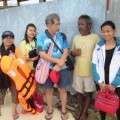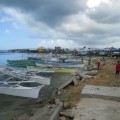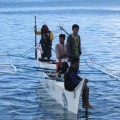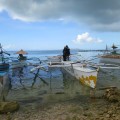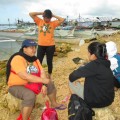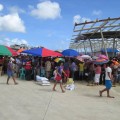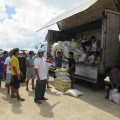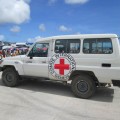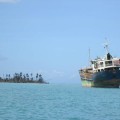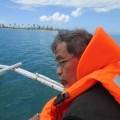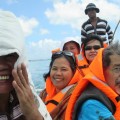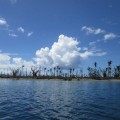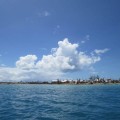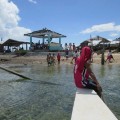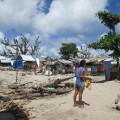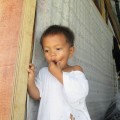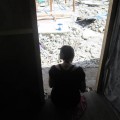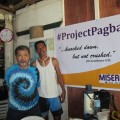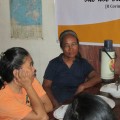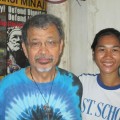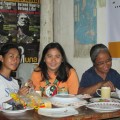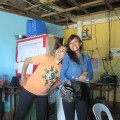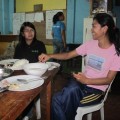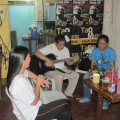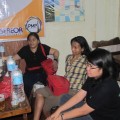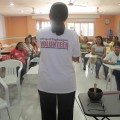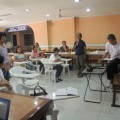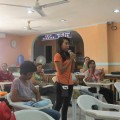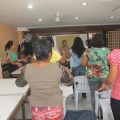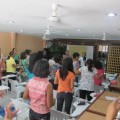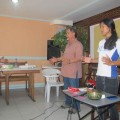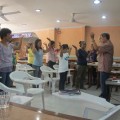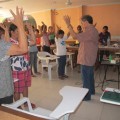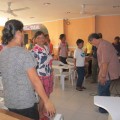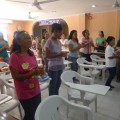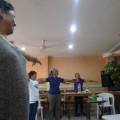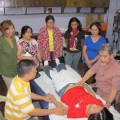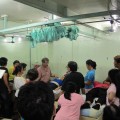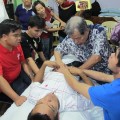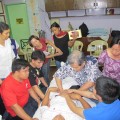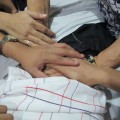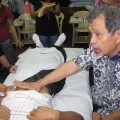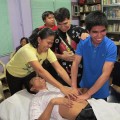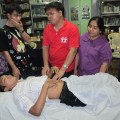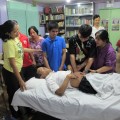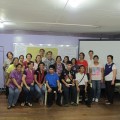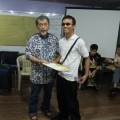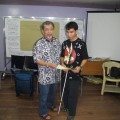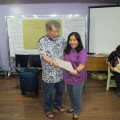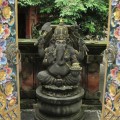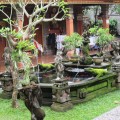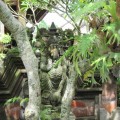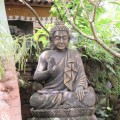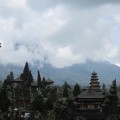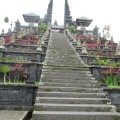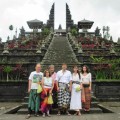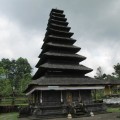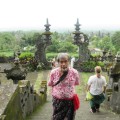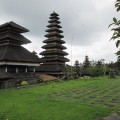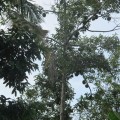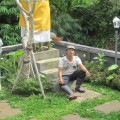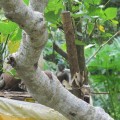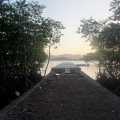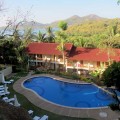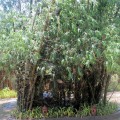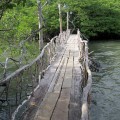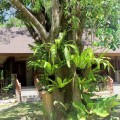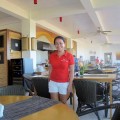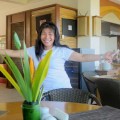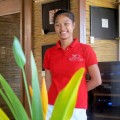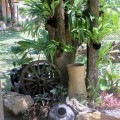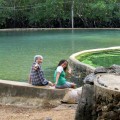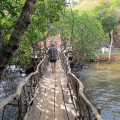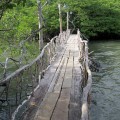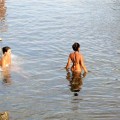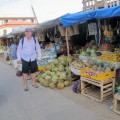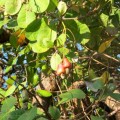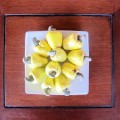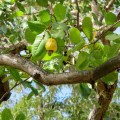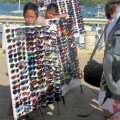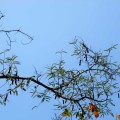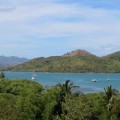The sea was the bluest blue, and calm. Still, we had anxiety about the sudden change in the weather. We can trust the sea, but I have had the experience of sudden squalls and rains in Coron, Palawan just a year ago. We were welcomed by children who were taking lessons in drawing. They were waving their art work when we arrived. The boy was in the house where we had lunch of boiled squid, chicken adobo and fish soup. That’s Sonia sitting on the top of the stairs surveying the scene of destruction and children playing basketball with a tennis ball and a goal put together with a wire for a goal and pieces of lumber for a backboard.
Blog
Guiuan, Eastern Samar
We taught a combination of qigong and massage. Women from different islands in Eastern Samar attended. We listened to their stories. A 16-year old, encouraged by her mother, talked about her experiences.
The restaurant was one of the buildings spared by the typhoon. There was a sound system, chairs, toilet facilities and air-conditioning. We had one class here. About 40 women from different islands attended.
February 2014 – Manila
Dear Friends,
The geographic trajectory of my recent journey to the islands of Leyte and Eastern Samar in Central Philippines is easy to follow: a flight on Sunday afternoon February 2 from Manila south to Tacloban City, Leyte, one of the most devastated areas in the country. On arriving at the airport in Tacloban City, we took a rental van past the famous San Juanico Bridge to Guiuan, a town in Eastern Samar. It was a 3-hour journey through beautiful but desolate landscape, the sea and islands to the right, mountains to the left, and coconut boles that had lost their fruits and leaves dotting the scene. The last hour of the trip at sunset was over pitted and cratered roads, a white-knuckle route made scarier by a race-car wannabe for a driver, tricycles (motorbikes with a sidecar, which are called tuktuks in Thailand and cyclos in Vietnam) and chickens and dogs and people crossing our path in the darkness.
From what I have seen, the destruction – physical, material, psychological and spiritual – was unimaginable. Photos can suggest but not capture the extent and depth of it or its direction. How do you draw a map of psychic damage and injury? We were speechless as we passed tent cities, corrugated iron shanties, heaps of garbage and debris, steel and wooden frames bent like match sticks, posts snapped
in two, uprooted trees, cars sitting on top of rooftops, endless assortment of detritus. I haven’t seen anything like it in my 73 years on the planet. Estimates could be drawn for the wreckage of buildings and assets, but who can arrive at the cost to the human psyche? How about the damage to the children?
From Guiuan, Eastern Samar, we rented and crowded into a small pump boat to take us to Victory Island 45 minutes away on a calm blue sea. “We” refers to Annie, Ellen, MariCris, Sonia and me. Annie, Ellen and MariCris are INAM Philippines staff and acupuncturists. They did acupuncture. I, an INAM consultant and visiting professor, led qigong and massage exercises. Sonia, a yoga teacher and raw food chef and a volunteer, taught basic yoga to the children. INAM organized the February mission after a first one in January.
When, on a bathroom break between Tacloban City, Leyte and Guiuan, Eastern Samar, I asked a storekeeper if she had bananas to sell, she said they had all been blown away by the wind. The reconstruction is going to take years. Five years is the minimum period before the coconuts bear fruits again, if at all. Meantime, where will the people find the food to eat? It takes about 6 months for rice to be harvested. Vegetables take at least a month, pigs and chickens at least 2 – 3 months. The land has been salted over by the sea – will that be a problem to agriculture? International and local rescue and relief operations are ongoing. The recovery has already started. We saw a group of fishermen building boats at Barangay 89-90 in Tacloban City. But how long will it take just to clear the debris and heal the people of the trauma from the typhoon? Haiyan (called Yolanda in the Philippines it possibly means sea – hai — voice — yan — ) packed 190-mile winds for several days. Somebody described the experience as like being in a giant washing machine: getting churned this way in the beginning and that way next, and then being squeezed and turned the other way, and then being washed again and again with the repeat cycle on. Well, add the vicious and relentless winds to the mix. The picture reminded me of the senseless suffering of an innocent child. Why? How do you explain the existence of such existential horror? All it suggested was not only the indifferent universe of Camus (in the Plague) and Dostoyevsky (in Brothers Karamasov) but an angry and merciless god or the trial of Job in the Old Testament.
The horror recalled an early childhood time back in the mid-1940s when a typhoon broke. My family and I (father, mother and 2 children) lived in a 10 feet x 10 feet one-story house standing a foot above the ground in my hometown of Bamban, Tarlac. The wind blew and whistled for hours. Afraid we would be drowned, an uncle “evacuated” us to his house next door that had a second floor and was definitely more solid than where we lived. The memory has remained with me until now.
We stopped for 2 nights at Guiuan to teach and share Qigong, meditation and massage techniques. You’ll probably not see our next stop, Victory Island, on the map because it is just a dot in the sea. Go now, said an area resident, while it is still there. The unpredictability of the weather made us anxious: in the region people talked about the amihan or the habagat, winds that descended even during calm days and nights. There was also a tropical depression the day before we departed Manila, strong enough to be called a typhoon; luckily, it left just when we arrived in Tacloban City.
At a session in Guiuan, we listened to the women who arrived in boats from different islands. We heard about their fears and nightmares when there is a strong wind or news of another storm, what triggers their fright and sense of helplessness. Encouraged by her mother, a 16-year old girl stood up and told the gathering about her vulnerabilities and worries. She was advised by her doctor to see a psychologist. The stories were so horrendous a group of acupuncturists who came earlier reportedly had to have treatments from a psychologist because they were themselves traumatized and were haunted by “ghosts.” One question I have often asked myself, How can you relieve human suffering with an acupuncture needle? I know there are acupoints that are effective for stress, for relaxation, but how do you get people to eventually help themselves and find peace and quiet and courage and leave that painful period behind?
My own humble approach is, in addition to acupuncture, to teach Qigong, empowerment, tuina/massage, protection and meditation techniques not only to the victims but also to healers. We named the protocol “INAM TaoRen Therapi,” part of the development of a Philippine approach to healing called integratib Medisin. We combined different acupuncture points – Kiiko’s Triple Intestine near the elbow, CV 6, GV 20, LI 4, LV 3, and a few others on the extremities. The Qigong and Tuina, involving massage, sounds and visualization included activating the Jing/Well points of the hands and certain areas of the body – Lung Mu, Stomach Mu, back of the knees, Zu San Li, the Gall Bladder line — and covered the sacrum, lumbar, shoulders and spine. The massage techniques are important because they are an essential link of human connectedness. Touching, a simple gesture, is a way of reaching out. The protocol is not a complete solution, far from it in fact, but it is what we can offer for now. Eventually, the acupuncturists, the teachers and the healers (there are also psychologists there) will leave and the typhoon victim will have to fall back on her own resources … and face or exorcise her ghosts. Alone, perhaps in the middle of the night, an area resident will need accessible techniques to cope. Or, together the victims will have to support each other ultimately with methods of facing up to the traumas … methods of self-cultivation or nurturing the body, mind and spirit. So we advised them to make the practices an integral part of their lives and their culture. We trained them – I hope well enough for the short time we had — to be familiar with the methods so that they can do the practices as well as teach them to friends and relatives in their remote neighborhoods and villages. Parts of the armamentum are simple methods of breathing, healing sounds and colors, meditation, and movements of taoyin or qigong and massage to learn to let go, reestablish human connection and restore the spirit. Hopefully, the practices will provide some form of relief and strength now and closure later.
INAM Philippines is only one of the many different organizations providing healing
and therapy to the population. The INAM staff is planning to return in March. I will join them in Guiuan, Eastern Samar and Tacloban City, Leyte, and the farther island of Homonhon in early August.
Thank you for your help.
Love and Blessings from the Philippines!
Rene
PS:
I don’t have a Twitter or Facebook account. If you have the time, look up the website of INAM Philippines for more photos of the mission. Sonya Astudillo, the yoga teacher, also has photos on her facebook page. So does Maria Cristina Parungao, the INAM director.
Gallery: Chi Nei Tsang internal organs massage seminar
Chi Nei Tsang internal organs massage seminar sponsored by INAM Philippines, an NGO that services
the disadvantaged population of the country. There were 8 blind/visually impaired masseurs, 7 women from Bulacan (fisherfolk), 5 acupuncturists, and several laypeople who are interested in healing and self-development. It was a 2-day seminar (from 8 to 6).
One time, I was teaching a qigong movement with the hand. I said, Start from 12 o’clock, move to 3 and then 6, up to 9 and back to 12. I realized later on, when I got a feedback, that the blind have not seen a clock, they have no idea of how it looks. They perceive time in terms of movement and light, the chirping of the birds, and the humming of the earth.
So when I taught an abdominal manipulation I asked them to put their hands over mine. What an experience!
Gallery: Pictures from Bali
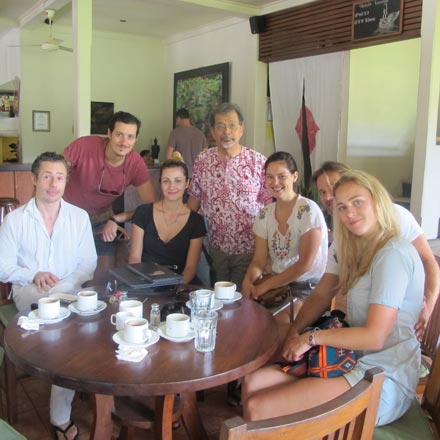
Breakfast with Pothis, Leanna, Rene, Zoe, Rik and Emma, participants at the seminar conducted by David
Verdesi (seated at the left) in Ubud, Bali January 5 to 16. Imagine having Huevos Rancheros with fresh coconut
juice and expresso coffee Balinese style!
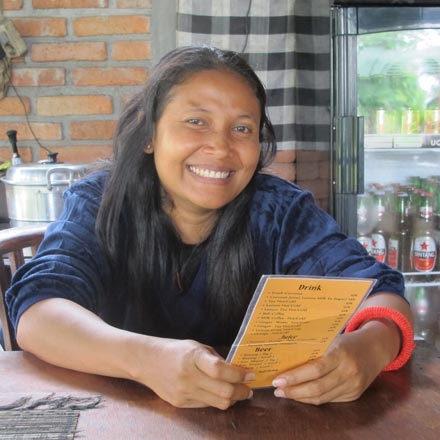
Nyoman, proprietor of roadside restaurant that serves grilled fish, chicken, pork spare ribs and duck, and a variety of veggie dishes — beans, water lily/kangkong — and fresh coconuts. They have a great lemon grass and wild ginger tea.
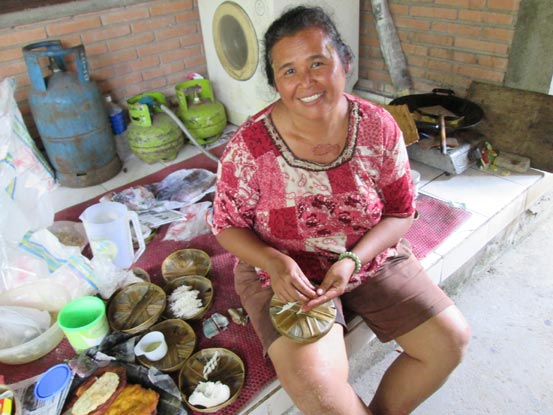
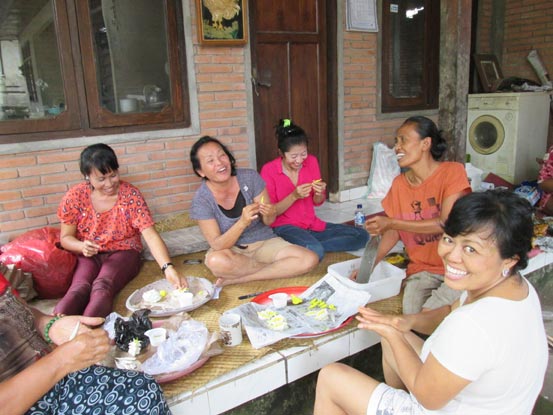
Women preparing a delicacy made from ground coconut for a family wedding.
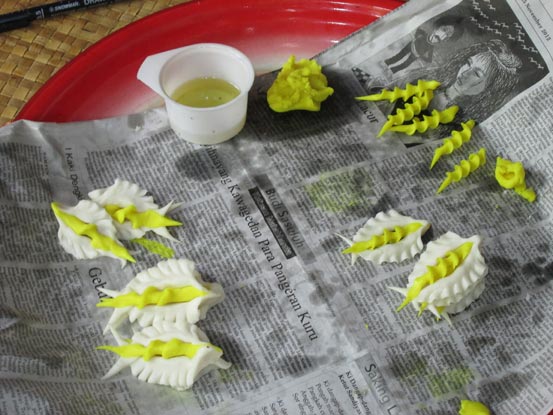
Besakih Mother Temple on the south slope of Mount Ugung. Pura Besakih is the holiest and largest Hindu temple in all of Bali. We made a pilgrimage on my last day on the island, organized by the shaman Sonya (fifth from the left). We were led by a Hindu priest whose presence was nothing short of overwhelming. He solemnized rituals for us on the different levels of the temple complex. He gave me his personal blessing for my healing work.
(Click on the thumbnail pictures to enlarge.)
January 2014 Update
January 12, 2014, Ubud, Bali, Indonesia
Dear Friends,
I arrived here in Bali from Manila very early morning of January 4. I mean at 2 am. After Immigration, baggage claim and customs, it was 3 am and by the time I got home it was 4.
The training started the next day. A long introductory meditation by David Verdesi on samsara, emptiness, spontaneity, taboos and the Self. You can read about him in my website in the essay “Thunder Path in Huangshan.” He is a phenomenal teacher and a great friend.
The seminar finishes on January 16. I am scheduled to leave on the 18th. But I thought of staying longer, perhaps until the end of the month. I am supposed to teach seminars sponsored by INAM Philippines again. No date has been set yet although I have been thinking of February 8, 9 and 10. One day for Chi Nei Tsang Internal organs review, one day for Tai chi review and one day of qigong empowerment for the INAM acupuncture staff. These are preliminary and introductory seminars. We will have more and longer seminars in August and September involving the visually impaired, battered/stressed women, homeless “street kids,” Tai chi chuan practitioners, and therapists, acupuncturists and healers.
We will send out requests for donations in a month or two to support these seminars. How and where to house the participants, feed them, and bring them to the venue are questions INAM is addressing right now.
The first week of David’s seminar is done and now we’re starting the second phase: a training with mirrors (one for each of us) and candles, with David Verdesi starting the session with chanting and invocation with a ritual phurba in the darkness. It was quite hypnotic and mystical and shamanic.
To me, the training is a great departure from earlier seminars that, more or less, dealt with the development of power. Well, they had aspects of self-cultivation and spirituality, but they were essentially focused on
developing abilities. This time around David is zeroing in on consciousness and the Self and freeing the Mind from cultural, moral and religious restraints, many of them self-inflicted, and taboos.
There is also something else that’s different in the seminars. David is not charging tuition. Payment is on a voluntary basis. He is also taking in students as long a they are interested to learn. There is apparently no prior screening. A woman from Australia whom we met at a restaurant joined the group. An Italian woman who teaches yoga and Pilates joined us, too.
I have just bought a copy of and seen the Emmy Award-winning “The Ring of Fire” DVDs of Laurence and Lorne Blair. If there’s anything as a must-see travelogue, this is it. The narrative is moving and touching, it is difficult to find one like it. The brothers brought to the world the unbelievable Magus of Java film clip, now a part of youtube.com and seen by thousands of viewers. The Ring of Fire they refer to includes countries and places that are volcanic – from Hawaii to Indonesia, Japan to my country the Philippines. There are several active volcanoes on the island where I lived for 30 years – Mayon, Pinatubo and Taal. Mayon is one of the most beautiful volcanoes in the world. Taal is probably the most picturesque of the three: it is a lake within a volcano within a lake within a volcano. You can see some of the photos in my website blog, too. Pinatubo was arguably the most destructive: its lahar buried towns (like my hometown Bamban) around a 100-mile perimeter and belched ashes into the atmosphere that drifted as far as California to the west. It is now a place of desolation, its inferno somehow, in the meantime, tamed to sulphuric landscape.
What is it in Bali that draws seekers and pilgrims (and bums, tourists, and explorers) to her? Down the street and in temples (5000 according to one statistic), you’ll see tourists with their flip-flops, New Age clothes, pendants and tattoos along with pilgrims in native garb. No, I did not see any notices of channeling or promises of ascension and rapture anywhere. There are yoga studios, vegie and detox retreats, Tai chi training and massage centers, Tarot cards and astrology readers. There is the Falun Gong advert inviting everybody to a free lesson.
During my first visit here, I had just come from Java where I saw the famous Magus, John Chang. I had first read about him in a book “The Magus of Java — the Training of a Taoist Immortal” by Kostas Danaos when I was teaching in Amsterdam about 13 years ago. The author said that the Magus could burn paper, move objects, emit electricity from his body. Five years later, I was in Istanbul as the guest of David and I heard him talking to somebody on the phone. “Shifu, Shifu,” David was saying. I asked him, “Who is that?” David said, “The Magus.” “I want to see him,” I said.
A year later, in January 2006, David sent me an e-mail. “Come to Java,” it said. I took the next plane. It brought me to Frankfurt, Singapore and finally Indonesia, where I was picked up at the airport by David and Wedha, a friend. The next day David took me to see the Magus. David asked him to do a little demonstration for me. The Magus put up his right arm and said, “Touch me.” I felt this strong, shocking current of electricity. “That’s 5% of my power,” he said. He did a few other demos for me. He also gave me a successful, but painful, treatment for a rotator cuff injury that nothing – acupuncture, herbs, massage, qigong, laser – could correct. Western medicine required surgery, and even that did not guarantee success. You can read about it in the essay “Thunder Path in Huangshan,” in the Writings section of my website. Many readers of my website have asked me, “Where is David? Where is the Magus?” David has a website; he lives in Bali. The Magus is somewhere in Java.
Wedha, the nephew of the Magus, invited me to Bali to meet an old shaman who could transform himself into a monkey. A skeptic, I wanted to see this incredible phenomenon since a friend told me about seeing a shaman change into an eagle right before his eyes. When Wedha called him, he was told the old man was away.
Wedha took me to meet his relatives, a couple, instead. They lived in a huge compound. At the time they were building a library and museum for their antique collection of batik and other Indonesian arts. They were swimming in their pool when we arrived. We were introduced to each other. The man emerged from the water, shook my hand, and said, “Mr. Navarro, it would be an honor to have you stay with us.” I was supposed to stay in a hotel by the beach, but this was a surprisingly generous offer I could not refuse. I stayed with them for a week. They gave me the use of a car and a driver and a house. Wedha was told to sleep in a couch in the library. I said, “He can stay with me.” They’ve invited me to visit a few times but it was not meant to be.
In January 2012 I was here for the second time to train with David. I wrote about it in my website blog. David took me to see an old shaman, 92 at the time. David was initiated into the fold by the shaman himself. David also took me and others to see a Hindu priest of the fire tradition. One day if I can find them, I’ll post photos of myself receiving a fire treatment. It was elaborate but essentially passing a hot burning chisel over my tongue 9 times in one round; 3 rounds were required in one night. A total of 3 nights. It was considered in the lineage as a ritual of purification, healing and cleansing. Seems absurd from a western viewpoint, but in a world of correspondences, it makes sense: the tongue is the opening and extension of the heart. And what else is more cleansing than fire?
Yesterday, David talked about the taboos, many programmed by religion and culture, some self-imposed, attachments that limit the freedom of the Self to grow and explore. There are people and institutions and morals that try to fit us into a box. What/who is the Self? It’s too long and complicated to summarize here. The essence of it is the Self we or others perceive is often not the real Self. It is just a collection of ideas, memories, experiences. He talked about masters who were basically outcasts, extraordinary people who did not conform.
Last week David took me along to see a couple, healers who have a very interesting history. He brought a Russian whose lumbar spine was shattered from an accident. The man cannot walk, is on wheelchair, has had 3 surgeries and wanted to get healed by the couple. The Balinese healers look like ordinary people. The wife is a devotee of Guanyin, the Goddess of Mercy. I have been one myself since the early 1960s when I studied a Buddhist Shaolin Kung-Fu set called “Fairy Child Praying to the Goddess of Mercy” with an old Chinese master. One day Guanyin (“she who hears everything”) visited her and touched her big toe. From that time on she had this “electricity” she could not control. Was it kundalini? Perhaps yin-yang gong? Then 3 years ago, with this energy under control, she began to do healing. Her husband was of course jealous of her abilities. She prayed that Guanyin would grant her husband this “power,” too. Now they are doing healing together. I have seen only a few people like them with this strong current, one of them in Java (The Magus), two or three in China (the hermits of Huangshan) and of course David. The current runs and feels like electricity, but it is not. David said it is like radio waves. Water that was infused with it acquired an element that made it sweet.
I was privileged to receive treatment with this “yin-yang gong,” so called because it is supposed to marry the positive and negative in the dantian/field of pills. The couple also allowed me to observe their work and to assist them with the Russian patient in the next few days.
A tantric master, a friend of David, who spent 15 years in total isolation in the mountains has been invited to join us for a few days to share his healing work. That means not only additional materials but also additional hours. David said we may have to stay up past midnight. I guess that’s going to radically limit our night life. Not that I have one.
David promised to take us to see more healers. And of course the mysterious Coconut Man, the master who one day discovered his “powers” when a coconut fell on his head!
Love and Blessings from Bali,
Rene
August 2013 Update
Dear Subscriber,
Two seminars are being planned for this year in New Jersey. One is going to be held at the First Presbyterian Church in Alexandria. It will be about Taijiquan DaoRen, the short form based on the movements of the Traditional Yang Family fist form. The other seminar is still being assembled and will be sponsored by the Hunterdon Medical Center. More about this later.
I will be quite busy during my sojourn in my country next year/2014. INAM (Integrative Medicine for Alternative Healthcare), the NGO that sponsored many of my seminars since 1998, is organizing seminars between August 21 and Sept 19, 2014. A short seminar for blind masseurs and masseuses has been scheduled for December 30 and 31 this year during my Christmas visit.
Included in the schedule in 2014 are these subjects:
Chi Nei Tsang internal organs massage
DragonWell Qigong
Xing Shen Zhuang Fa
Zhan Zhuang/Qigong Foundations and Taijiquan DaoRen
8 Extraordinary Vessels
Sword of Protection and Empowerment Qigong
6 Healing Sounds and 3 Breaths
Buddhist and Daoist Qigong
We will work with different groups: “stressed women,” “street kids” who live in shelters, blind bodyworkers, therapists and acupuncturists. Each group will have its own seminar. This will be a big challenge for everybody involved.
The Zhan Zhuang/Qigong foundations – Taijiquan DaoRen and Chi Nei Tsang will be open to the public and those who have taken Taijiquan with me. Get in touch with INAM for details. If you are not from the Philippines, you can still join the public seminars … and pay only the local tuition. There’s nothing extra but you will have to arrange your flights and board and lodging. There are many restaurants, B&Bs, hostels, boarding houses and hotels in the area.
For those who are interested in seeing the Philippines, there are many places you can explore: the famous rice terraces up north, Palawan and its underground river and quartz islands, Bicol and Mayon Volcano. The Philippines has 7,000 islands: you can look up your travel guide and decide which one impresses you.
I have taught many seminars in the Philippines. You can find the flyers in my website.
In the Writings section, there’s an essay, first written 10 years ago, now updated, about the legendary Tai chi chuan master Cheng Man-Ch’ing/Zheng Man Zing and raises the questions: How long did he study with Yang Cheng-Fu whom he claims as his teacher and what did he study with him? It is by no means the last word on the subject. If anybody is privy to materials about it, please step forward. I will be happy to be corrected if you have documentations and evidence that would be relevant to the colloquy. There’s also another essay about what I believe Tai chi chuan is all about. It is my own personal approach to the art as I research its sources and potentials.
Last but not least, I am reprinting my tribute to Grandmaster Johnny F. Chiuten, my first Shaolin master, whose third death anniversary is being observed this coming September. You’ll see it in the Blog along with several photos.
Blessings,
Rene J. Navarro
www.renenavarro.org
Johnny F. Chiuten: Fighter
I was in the Tao Garden, Doi Saket, Chiangmai, Thailand, attending the International Congress of the Healing Tao last September 2010. Recovering from jet lag, I received the first of many messages in the evening. One was from Ned Nepangue, a friend from Cebu, Philippines, asking me to call Johnny. Then another e-mail from Vic Ramos, a fraternity brother of Johnny’s, came within a few minutes telling me that Johnny, my “old sparring partner,” had passed away. Myla Salanga, his daughter, who lives in California, sent me the same message. So did Jopet Laraya, my martial arts classmate and Johnny’s disciple, from Hongkong.
A few more messages came, confirming Johnny’s death and sending me condolences.
The next few days I walked in a daze. I taught a couple of classes at the conference, one of them a sequence called “Twin Dragons Chasing the Pearl,” from a form – Cross Fist — I learned from Johnny in 1964.
Johnny was my first Shaolin master. He was one of the constants in my life, a great influence on my journey. I met him back in the early 1960s, a great presence in the university campus, a respected member of the Beta Sigma Fraternity. He used to come to my dorm room to teach my fraternity brother, a student of law like me. They would practice right there in the small space beside the bunk beds.
One day, Johnny and I met at the law school cafeteria and sat down at the same table. He asked me why I was not studying with him. I said I did not know that I could. We made an appointment for a lesson right then and there. It was the most important decision I had made at that juncture in my life.
On my first lesson, Johnny told me to stay in a very low horse position when we began. What he did to me for the next 3 hours or so was incredibly graphic — and painful. He kicked me, pushed me, rode on my thighs and back, asked me to walk around, slapped me all over. It was something I had not seen even in the kung-fu movies where the hero was asked to do 100 repetitions of a technique until he was bone-weary. Johnny’s method, presumably transmitted from Grandmaster Lao Kim, was meticulously sadistic in a benevolent way. I mean it was meant for a purpose, and that purpose was to test my patience, endurance and determination, and inculcate in me certain mystical values, and to build me into a warrior. Well, I don’t know if I became a warrior, but it certainly tested my patience. As for the mystical experience, I think I attained that, too, because at a certain point when I was about to collapse, I felt an enormous energy welling up, I saw a different reality, I reached a different level of awareness. I came back the next week and took some more of the same punishment. By that time, the novelty was gone, and I was ready to endure because I knew that to have a view of what it is at the top, you have to climb the mountain, by yourself.
When he graduated with a degree in pharmacy, after shuttling from one course to another to prolong his Kung-Fu studies with Grandmaster Lao Kim in Manila, he went home to the island of Cebu to run the family business. On one of his visits to Manila, he introduced me to Lao shifu, then in his 70s, and asked him to take me as a private student. The old man could not turn him down because Johnny was like his own son. It was a rare opportunity for anybody to be taught as an indoor disciple by Lao Kim, at the time considered to be the patriarch of Chinese Kung-Fu in the secretive world of martial arts in Manila.
Whenever Johnny visited Manila, we would get together to take lessons and have dinner with Lao Kim. Johnny would also show me his new fighting techniques. One time, he stayed in Manila for a month and he and I studied Yang Family Tai Chi Chuan and Pa-Kua Chuan at Hua Eng Athletic Club in Binondo. He learned both 108 solo form and Pa-Kua in just a couple of weeks. When I saw him again, he had added astonishing components to his system: potent jing and trapping. That’s how he was, a serious and dedicated searcher. He studied karate, kundalini yoga, Tetada Kalimasada, he was a black belter in aikido. He was into cross-training and mixed martial arts even before there was a name for them.
In late 1970, I migrated to the US. I studied with Mat Marinas, an arnis de mano/Philippine stickfighting master in Queens, NY. Meantime, Johnny began exploring the different styles of stickfighting (also called escrima) in Cebu. He studied different styles and eventually developed his own system called “Arnis de Cadena Pronus Supinus.”
There were times when yet another foreign delegation would come to see him. Johnny would make them wait on mainland Cebu while he stayed in Bantayan, an island that until recently was accessible only by land transportation and by ferry. I was with him in Bantayan in 2004 when he said how tired he was of the endless challenges he had to face in his life. But in his search he wanted to test himself against the best.
He had had several serious cardiac procedures since the mid-80s, one of them in Texas, and I did not think he should be fighting again and other practitioners should have respected the fact that Johnny’s body was no longer as supple and strong as in the 60’s and 70’s when he used to fight 4 opponents at the same time. Nonetheless, in the prevailing martial arts culture, there was no rest for the master.
Many martial arts practitioners pursued him for his combat expertise and his instructions but he never did divorce martial arts from the energetic and philosophical aspects of self-cultivation. He was always looking for techniques that used the mind and Qi without relying on the physical. He wanted to use Qi to heal himself and others. He was a fount of combat knowledge but he was also a wise man, a very rare combination in the martial world that is inhabited by many violent types and rarely by refinement. He was always respectful of others, even those who were cross and rude. To Johnny, fighting was pursued with the detachment of zen. He never did fight anybody out of anger or resentment or personal issues. In this he was unique in the martial arts world, I believe. After a fight, he usually shared his techniques with his opponent. He had an open and benevolent nature. He had a generosity and wisdom that was beyond the comprehension of the ordinary man. And he was always humble, never denigrating anybody, even those he had defeated in combat. He was a paradox in the martial arts world, gentle, thoughtful, hospitable, fluid. I could have sworn that he was a Taoist sage!
When he passed away on September 10, 2010, I lost a friend, master and guide.
Om Shantih Shantih Shantih
____________________________________
Stories about Johnny:
He told me about his encounter with a famous Filipino fighter who tried to ingratiate himself to him by taking him to places in California when Johnny was there to visit his daughter Myla and her family. Johnny expressed his doubts about the man’s intentions when we saw each other in NY while he was visiting his brother. “I do not know what he wants from me,” he said. When Johnny returned to California, the intention of the man became clear: he wanted a fight. This man was known as somebody who boasted about beating up people apparently to build the legend of his prowess. He also claimed he was a “psychic healer” and bragged about his exploits with women. As Johnny related the episode, this man said:
“Johnny, what posture will you take if I attacked you?”
“You will see if you attack me.”
The man attacked and Johnny pushed him against a wall. Johnny could have inflicted serious injury, but he used the Press technique from Yang Family Tai Chi Chuan that was partly meant to stop an attack in its track. I do not know if that was enough to bring this man back to his senses, he was not hurt but it was a shock and an eye-opener for him. Perhaps he learned a lesson from Johnny, but then again, I do not know. Johnny was terribly disappointed by the episode partly because this man tried to befriend him and abusing Johnny’s trusting nature, tried to exploit it.
This second story happened back in the mid-60s when Johnny was a student in the University of the Philippines. It was late at night and Johnny had just got off the bus from Manila where he had been training with GM Lao Kim. As Johnny was walking home, he encountered a group from a rival fraternity. He was surrounded by about 30 of them. When somebody attacked him, Johnny went into what he called “ground fighting.” In this technique, it was difficult to hit him because he was down there most of the time, kicking and rolling. He managed to escape and inflict some serious damage to the muggers. Later a cop from the campus security knocked on his door and asked him to go to the police precinct. The chief told him that there were complaints that he had attacked and beat up some fratmen. But it was a charge that was impossible to prove because Johnny was alone against a big group. The charge was dropped.
The third story I can authenticate myself. In the 60s we used to spend hours doing nothing but forms and sparring. In 1966, on a Wednesday at about 12 am, it was during the Holy Week, if I remember, we had a memorable match. We had had numerous fights before, at different places. Sometimes we started at 8 o’clock in the morning and we carried the exchanges off and on until 1 in the afternoon. But this was the first time he had resorted to the technique. During a furious exchange, he stabbed my left leg and I fell. A bubble of blood formed instantly. It was one of those moments when life passes in front of your eyes. Johnny showed me how to massage the leg and put the blood back into the vein. Later, the bubble appeared again and grew to the size of a baseball. I went to see Johnny at his house in the campus. He slapped the baseball and spread the blood all over my leg. He made me drink two cups of dit da jow liniment made of 36 herbs. The recipe came from Lao Kim. My leg was black and blue for a few weeks. It was one of the scariest times of my life. Asked about it years later, he replied, “You were going to kill me. I had to defend myself.” I am sure he was exaggerating my abilities — and intention — because during the years we sparred I had never been able to touch him. I have photos to show what Johnny did, one of them I cannot publish because it shows the moment he delivered the thrust of the finger. Footnote: Dr. Guillermo Lengson, vice president of the Karate Federation of the Philippines under Johnny in the 60s, who also studied with Johnny, said of his sparring sessions with Johnny: “Sinagasa ako,” (literally translated as “run over”) referring to the technique of non-stop attack that Johnny had honed to perfection. I take it as a compliment to Johnny that there are martial arts practitioners who have adapted the word “sagasa” to refer to their systems.
For more information about Master Chiuten, go to:
http://www.beta-sigma.org/
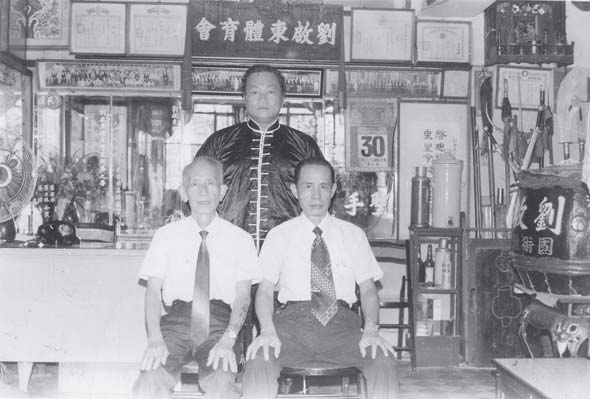
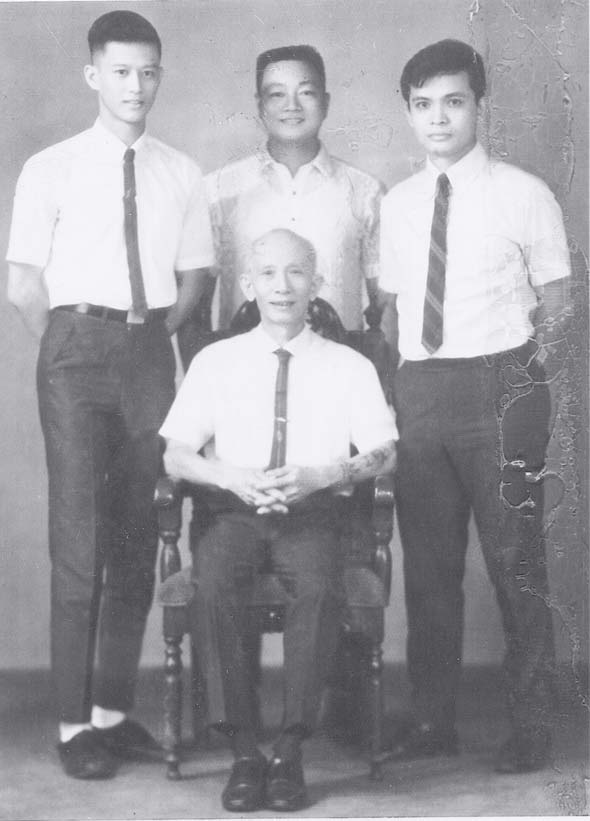
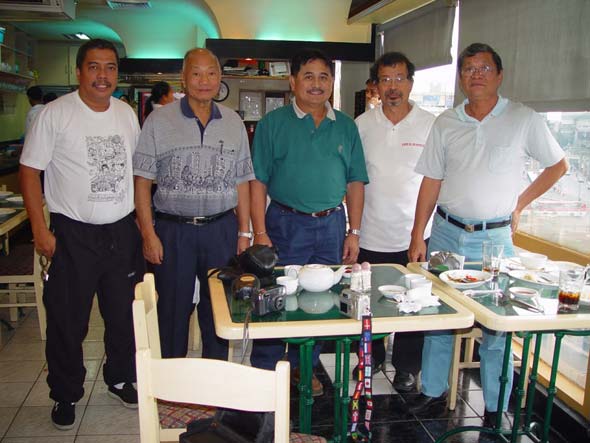
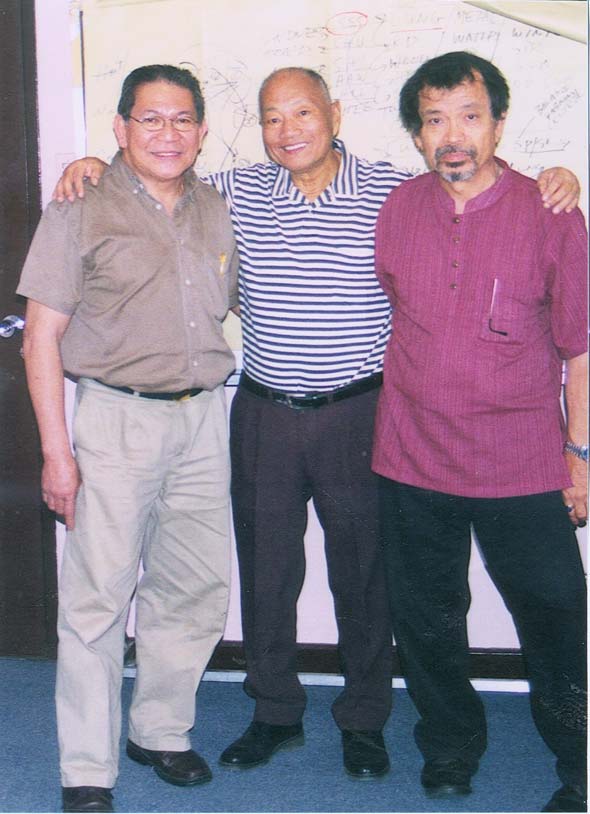
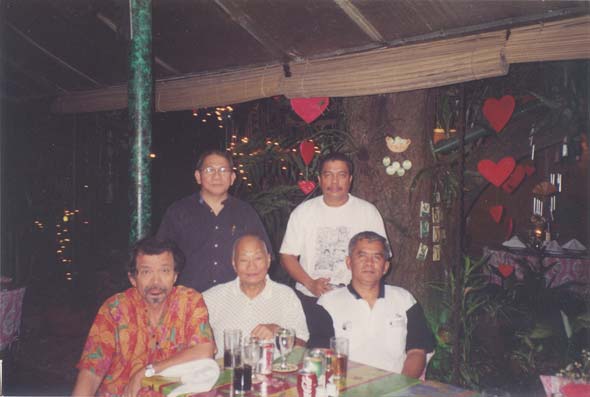
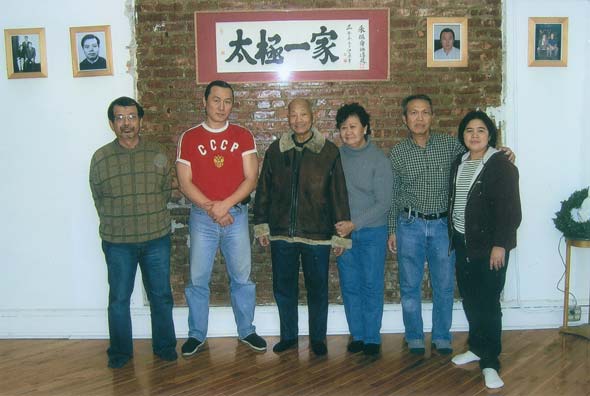
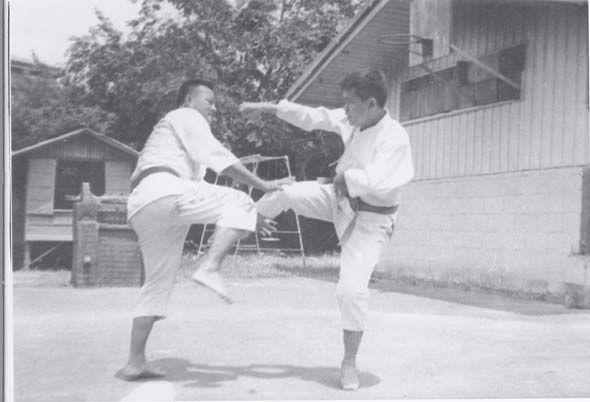
Photos from the Philippines: Luzon
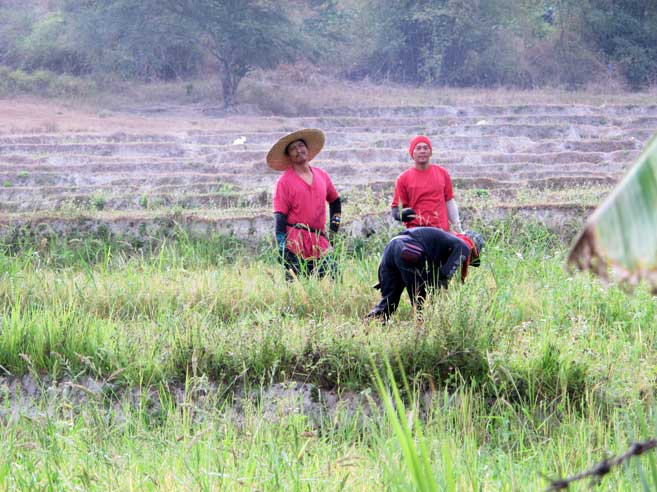 There was a short visit to Bamban, the old hometown, at the foothills of the Zambales mountain range. Farmers harvesting rice and a grandchild being held by his lolo.
There was a short visit to Bamban, the old hometown, at the foothills of the Zambales mountain range. Farmers harvesting rice and a grandchild being held by his lolo. .jpg)
There was an orchard of mangos, tamarind, guayabano, coconuts, and chesas and several tilapia ponds. Cousins prepared native dishes — bringhi (a village version of paella), dinuguan (blood stew with a lot of garlic and pieces of a pig’s head) and burung asan (fermented fish and rice which is used as a dipping sauce for ampalaya (bitter melon/gourd), okra and talong (eggplant) — and fried tilapia. On another occasion, we were served Philippine snacks — puto, cuchinta and tamales. There was too much to eat everywhere I went and I felt guilty for not being able to discipline myself.
.jpg)
Esperanza del Rosario, the widow of my former minister Philip at the Methodist Church, was the speaker at the Sunday church service in Tarlac. It was our first time to meet after more than 40 years. The gentleman with us was Cesar Graganza, a childhood friend from the old hometown.
.jpg)
.jpg)
In Quezon City, Ed Maranan invited me to the art exhibit of Joly and Jana Benitez, father and daughter, at Erewhon Gallery, in Old Balara. A photo shows one of Jana’s paintings. When we were introduced, she told me that she studied Daoist martial arts in Wudangshan. I wanted to talk to her about it but she was quite busy that night. I looked at her website and found that she lives in Brooklyn, NY and has studied art in many studios, schools and countries. An impressive CV for one so young.
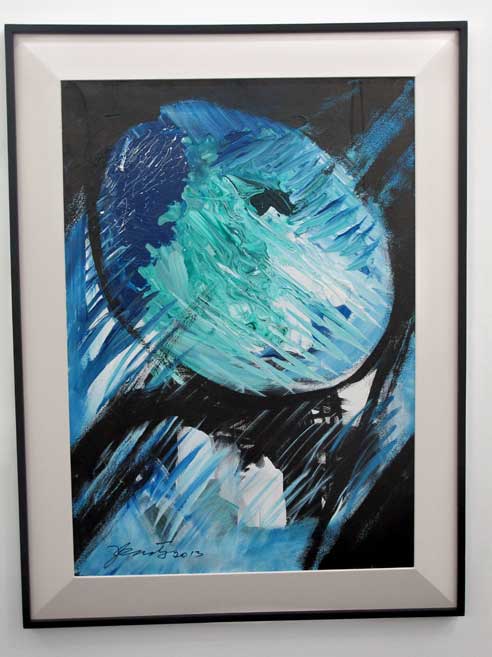
Ed and I were surprised to “encounter” Imelda Marcos in the gallery. She joined Helen Benitez for the photo op.
.jpg)
A photo shows me with the Maranan clan who own the Muang Thai Restaurant having dinner.
.jpg)
A 2-day Zhan Zhuang/Qigong foundations and Tai chi chuan DaoRen seminar sponsored by INAM, the center for integrated medicine that holds regular acupuncture courses, capped my Philippine visit. It was a fund-raising for their indigent project. INAM has organized many of my seminars on Tai chi chuan, Chi Nei Tsang internal organs massage, Qigong/Taoyin, and Microcosmic Orbit Meditation since 1998. Students, many of them working with the community, came from different parts of the country. A pleasant surprise: one time a woman from INAM gave me a massage. I did not recognize her, but I was surprised to receive a CNT manipulation. Photos show Annie Sollestre, who has studied with me for much of a decade, leading the class in the form, me supervising the class, the group posing for a picture after the awarding of certificates of attendance.
.jpg)
.jpg)
.jpg)
.jpg)
Gallery – Photos from the Philippines: Coron Town
Photos from the Philippines: Coron Town
{Click on the thumbnails to view larger photos.}
